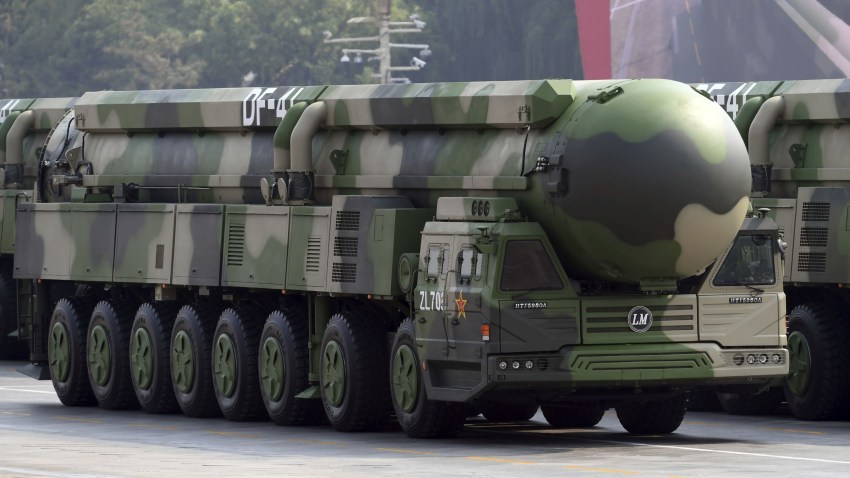Yet after Xi Jinping’s ascension to power in 2012, and in the context of mounting tensions with Washington, Beijing ramped up its modernization efforts and began to embrace new missions for its arsenal, including tactical nuclear strikes and nuclear warfighting. It developed and deployed intermediate-range systems like the DF-26, which is a dual system and has what military analysts call “hot swapping” capability, meaning it can rapidly shift between launching nuclear and conventional warheads, in addition to being accurate and having a sufficiently long range to reach Guam, a U.S. territory and key military outpost. Beijing, in other words, seemingly became interested in developing a first-strike capability against U.S. nuclear and conventional forces, as opposed to just possessing retaliatory second-strike options. In recent years, reports also surfaced that China was modernizing its nuclear command-and-control systems and conducting exercises to improve force readiness, including by mating warheads to missiles and possibly moving to a posture allowing Beijing to launch a retaliatory strike upon detection of an incoming enemy attack on its territory, known as “launch-on-warning.” Finally, China made no secret of its investments in cyber and space capabilities, and of its adoption of a deterrence posture that relies increasingly on assets from different domains, not just nuclear. Beijing has worked hard to integrate these capabilities, notably through the establishment of a new Strategic Support Force in 2015. The recent discovery of the new missile silo fields suggests that, in addition to perfecting its technology, China may now also be in the process of massively increasing the size of its arsenal. In hindsight, Xi had suggested that a build-up was coming. Since taking power, he has systematically emphasized the importance of the Rocket Force and, in 2017, as U.S.-China relations became more overtly competitive, he stated that China would have “the dominant position” in the world by 2049. It was not surprising, then, to hear him call for the military to “accelerate the construction of advanced strategic deterrent” capabilities in March, just a few months before the new missile silos were discovered. Behind this decision seems to be the belief that China can only truly dominate its rivals if it comes close to, reaches parity with, or even surpasses American and Russian nuclear stockpiles. For years, U.S. government officials and experts speculated whether (or when) China would abandon minimum deterrence and build up its nuclear arsenal. In recent years, several analysts have explained that China already de facto transitioned from minimum deterrence to limited deterrence due to the qualitative improvement of its arsenal and the new missions Beijing seemed to have embraced. While some observers have advanced alternative explanations, the silo news now appears to indicate that China may finally be in catch-up mode with the U.S. and Russia, and, therefore, that a new nuclear order characterized by tripolarity could be in the offing. Such a tripolar order would have many important implications. At the macro level, nuclear instability would likely increase. Scholars have long suggested that triangular interactions between states are generally unstable and prone to conflict. The late international relations professor Martin Wight, for instance, explained that “triangles tend to be mobile figures of shifting alliances and negotiations,” adding that “like duels, [they] are relationships of conflict, and are resolved by war.” Other research has reached similar conclusions. Such a tripolar nuclear order would be particularly problematic for the U.S. because it would likely get the short end of the stick. Washington is increasingly competing with both Moscow and Beijing, yet the latter two are expanding and deepening their strategic cooperation to counter the United States. To be sure, Russia and China are not nuclear allies, and that is unlikely to change in the near term, whereas the United States has nuclear alliances with France, the United Kingdom and NATO. Still, a major nuclear build-up by China would almost certainly put the United States in a less advantageous position than today. It is tempting, in these circumstances, to consider arms control as the solution. Following the extension of the U.S.-Russia New START agreement earlier this year, and in the context of ongoing strategic stability talks between American and Russian diplomats, it is possible to conceptualize various arms control arrangements that would involve China, be they trilateral or multilateral. An alternative could be to jump-start a separate U.S.-China negotiating track. The challenge, however, will be to get Chinese buy-in. Beijing has rejected any form of engagement on nuclear issues, including on crisis management, and so far, neither inducement nor pressure has worked to change its mind. So, unless there is a breakthrough, expect a bumpy, perhaps even dangerous nuclear future.The silo news now appears to indicate that China may finally be in catch-up mode with the U.S. and Russia, and, therefore, that a new nuclear order characterized by tripolarity could be in the offing.
David Santoro is president and CEO of the Honolulu-based Pacific Forum. He is the editor of a new volume, “U.S.-China Nuclear Relations: The Impact of Strategic Triangles” (Lynne Rienner, May 2021). Follow him on Twitter @DavidSantoro1.
Miles Pomper is a senior fellow at the James Martin Center for Nonproliferation Studies at the Middlebury Institute of International Studies.

